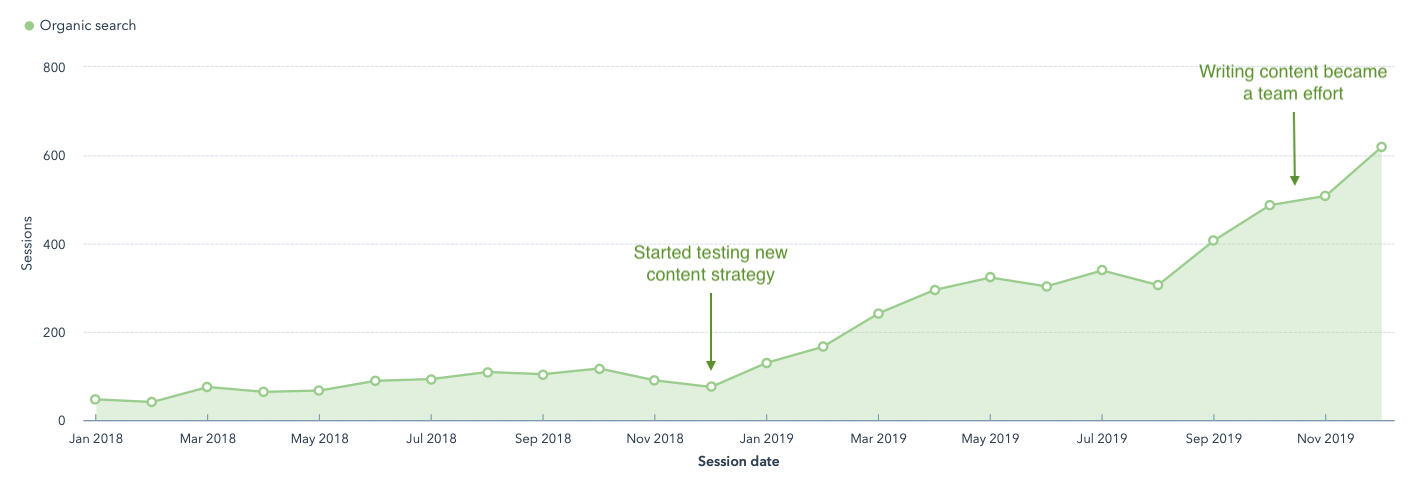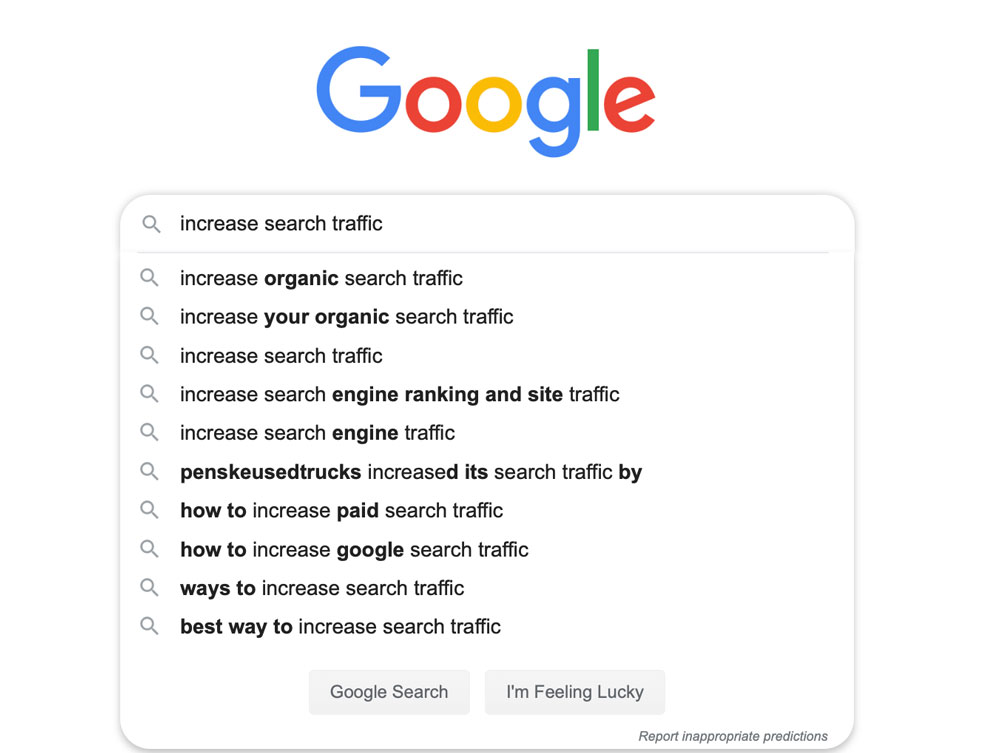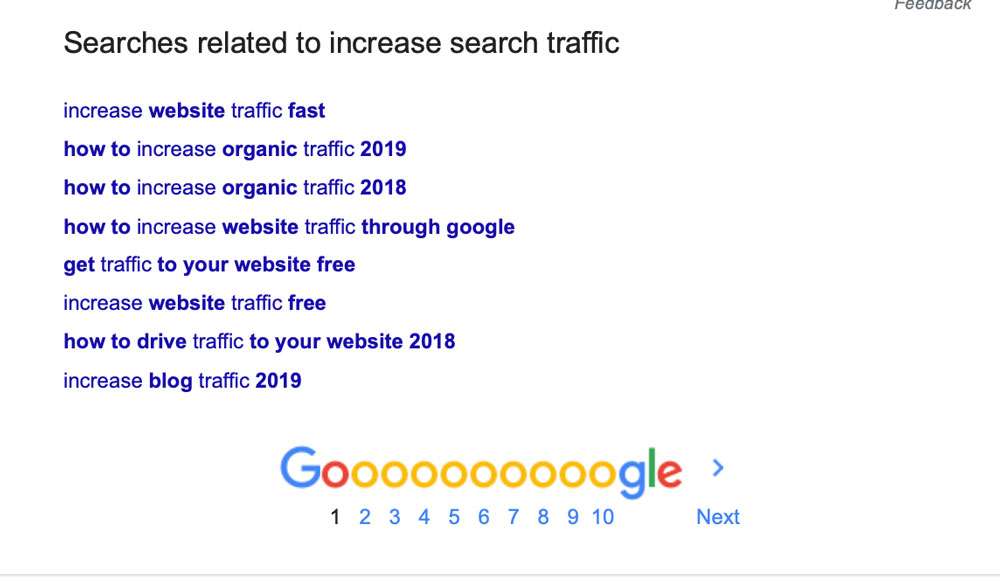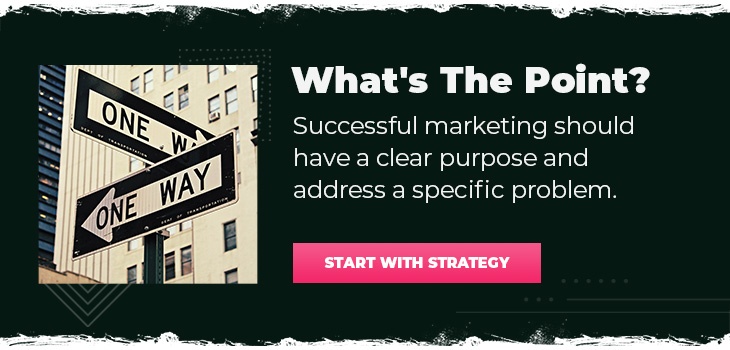People like to read big percentages in titles. The downside is that they are often unbelievable. I know my reaction tends to be “there’s a piece of that story they aren’t telling me.” That’s understandable. I’ll make you a promise: I will share with you every step we took to increase our organic traffic by 324%. I’ll give you as much context as I can. In the end, I think you’ll see how attainable that number is, and hopefully, you’ll be as excited about your content as we are about ours.
What Is Organic Website Traffic?
Organic traffic is website traffic that comes in through a search engine. It didn't come from paid ads, rather it came up in the top search results "organically," and you didn't pay for a user to click on it.
A user searched for a term that represented their need, and your brand came up as a result. They clicked it and landed on your website. They're exposed to your brand and potentially interested in a service you offer. You have the opportunity to educate and establish a trust relationship with them. Plus, you can prove that you are an authority in the industry.
When we talk about building organic traffic on a site, we are most often referring to "blogging" strategy. Just a few years ago, blogging was a thing reserved for DIYers and home cooks. These people presented their hobbies in a way that captured people like me and made a career out of becoming professional bloggers. But today, big companies have embraced blogging as a way to connect with their audience before they are ready to buy the product or service they offer.
Of course, organic traffic isn't completely free. Someone had to spend time researching keywords and search intent. There was time spent writing the article, editing it and formatting it before publishing it for the world to see. The difference is, you’re not paying a dollar amount for a single lead. Instead, you’re investing in something that will continue to drive traffic to your site over time. It’s an upfront investment with a continuous return.
Where Organic Traffic Can Deceive
It’s easy to increase traffic on a website. Find a low competition keyword with high volume, and it’s pretty easy to get the traffic for that keyword. But that doesn’t actually do much of anything for your business. Sure, you have people on your site, but they're leaving immediately because your services aren’t appealing to them.
This is where “intent” comes in. Intent is the type of solution your searcher has in mind when they type a phrase into a search engine. Google uses an advanced algorithm to match what the searcher types to the kind of results they want.
Just because you think the keyword you’re targeting is relevant, doesn’t mean that it matches the intent of your target audience.
For instance, at first glance, the term “website copy” might seem like a good keyword for us to focus on. We build websites; we write website copy for clients; it would make good sense to target “website copy” and get some of that traffic on our site. Right? But when we dig deeper, we find that “website copy” returns search results around copying a website, which is not the same as writing copy for a website.
How do we test intent? Type your search term into Google and see what results it returns. Remember, it doesn’t matter if you think the keyword is relevant; it matters if Google thinks it’s relevant.
Search Engine Optimization - The Key to Climbing Google's Search Results
You may have heard the term "SEO" or "Search Engine Optimization." SEO uses methods that some really smart people have developed to help Google understand what your article and website are all about. Google keeps a lot of how it ranks articles secret, but marketers and developers have run a lot of tests to figure out what works.
When we created a content strategy, it also included an SEO strategy. We identified keywords we could target that were relevant, had search volume and had low competition. We allowed our SEO strategy to add more context and validation to our content strategy so we could be sure to offer the kind of content our audience wanted.
Every new article we write is optimized for search engines. We aren't stuffing keywords into it, and we aren't using shady black hat methods. We use standard SEO practices to make sure the page is valuable, relevant and easy to use for our readers.
How to Increase Organic Search Traffic: What We Did
Step One: Make Sure Your Brand Message Is Crystal Clear
Our first step in growing organic traffic was to clarify our message with a methodology called StoryBrand. The StoryBrand Framework helped us define the problem our customer faces, the solution we offer and what success looks like after working with us.
That seems like a little much, right? You just want to write content, why do you need to figure out your brand messaging while you’re at it? Plus, your brand message is fine how it is.
Many companies assume they have great messaging, yet constantly field questions from prospects confused about what they do. The reason it’s crucial to get your messaging framework worked out before pursuing a content marketing strategy is to understand exactly who your character is, the problems they face, the role you play in solving those problems and what success looks like for them. You might think you have a handle on all those things, and if you do, great! But too often, there are inconsistent and even conflicting views on these key elements amongst internal staff. And when you get to the last step of your content strategy (bringing in the team), you need to be completely aligned on these things.
Step Two: Create Quality Content
Next, we began writing high-quality content around keyword opportunities that supported the services we wanted to grow. We focused on long-tail keywords with low competition, even if they had minimal search volume.
We began seeing results almost immediately. Our organic traffic was increasing, and we fell into a rhythm of consistently publishing new content.
In September of 2019, we began using a tool called Clearscope to audit the articles we were writing. We wanted to make sure we were using the target keyword to its fullest potential. We also needed to verify that we were writing content that responded to the searcher’s intent. It allowed us to easily integrate other relevant keywords into our copy, which made it simple to rank for more than one keyword in a single article. This allows us to get on the first page of Google with several articles.
Step Three: Refresh the Content Strategy and Bring in the Team
Up to this point, it was just two people working on content for Lone Fir. And while the growth was tremendous, that’s a lot of work for two people.
So in the Fall of 2019, we refreshed our content strategy and process to define the “buckets” of topics we wanted to go after. We did a ton of keyword research and created a process that would ensure every article aligned with our tone, voice and style.
After laying the groundwork, we got the whole team involved in producing content for Lone Fir Creative. We had more expertise to offer in our articles and more writers to add their voice to the mix. After all, the whole point of writing content is to provide value to readers. What better way to do that than to have our super-talented team share some of their knowledge?
Once we brought in the rest of the team, it also increased the network of people we could share articles with. Whenever a team member writes an article, we ask them to post it on LinkedIn and link back to the article on our site. This is an easy way to get more juice out of the content you spent so much time perfecting.
The Results

In 2019 we saw a 324% increase in organic traffic compared to 2018. That’s over a 3x increase in a single year!
Now I promised context...you’ll notice we didn’t have a ton of traffic on our site when we started this strategy. So, of course, that made it easier to grow at an exponential rate. That’s why we continued to develop and expand our content strategy. We want to maintain this momentum even as the traffic grows.
In the chart below, you can see the result of implementing these SEO efforts. We began to increase the number of leads and reliability of leads coming in quarter over quarter.
We use Google Search Console to keep a beat on which articles are moving up in search results and which are moving down. When we see an article start to lose traction, we consider if for a revamp. We wrote many of our articles before we had a clear brand message or a refreshed content strategy. That means there's a lot of opportunity to build on older articles to make them even more valuable and relevant to our target audience.
Beyond Direct Conversion
Clients always want to understand the direct ROI of any marketing initiative they take on. That makes sense because who wants to throw money at something that a random marketing agency told you you should pay them for?
The truth is that building organic traffic has more benefits than a simple article > lead > customer conversion. When you write quality, relevant content, you begin to educate your prospects before they interact with you. That means your sales team receives more qualified leads, making the path to conversion much easier. Here are two ways you can use the content you write before it ever starts driving organic traffic to your site:
- Sales Material: Write articles that respond to questions your sales team repeatedly hears. For instance, we are constantly asked about our pricing, our process and the platforms we support. Writing articles that respond to those three things save your sales team time, ensures each prospect gets consistent information and gives them a thorough explanation of each question.
- An Excuse to Send an Email: Nobody likes spammy emails. But what if you can send a prospect something that actually helps them? When you have pre-written material on your website, it’s a lot easier to send a follow-up email to a call that says, “Hey, I know you had questions about organic traffic. Here’s an article we wrote that explains the benefits/drawbacks/process in detail. Let me know if you have any other questions!” Blog articles also make great content for a monthly “newsletter” (I know, we hate that word as much as you do). Linking blogs from an email is also a great way to increase referral traffic to your site.
Just for reference, we recently sent out our first newsletter, which we are calling Marketing After Dark because seriously, who the heck wants to get a "newsletter." Bleh. The click-through-rate was pretty good for our first one, and the top clicks were all on the blogs that we linked in the email. - Share on Social Media: We're not saying you should only post articles in your feed. After all, that's a little boring and isn't what everyone wants on every platform. But articles are great content for LinkedIn, where you can share with your professional network and reinforce your authority in the space.
Our Next Step: Develop Backlinks and Add Internal Links
Backlinks, or inbound links, are links to your article from another site. According to Moz, "Backlinks are especially valuable for SEO because they represent a "vote of confidence" from one site to another." See how I linked to the Moz article that explains backlinks? Now they have an inbound link to their article.
Getting quality backlinks can be a challenge. Another website has to find your content so valuable that they benefit from linking to it. So what do you do? You offer other companies an honest and useful reason to link to you. Maybe it's your killer content that provides information not found anywhere else. It could be a report or case study that no one else wants to spend the time gathering data to write. Or it could be that you featured their company on your site like we decided to do in our StoryBrand Website Examples article.
One thing to note, there are plenty of companies out there that sell backlinks. But these are often low-quality and will not help your SEO ranking. Avoid these services and do the work to gather quality links.
What you just saw when we linked our StoryBrand Website Examples article is an example of internal links. Internal links are exactly what they sound like: links that go to other web pages on your site. Internal links give Google more context to your article and provide more relevant information to your reader.
Link building is essential to growing quality traffic on your site. So if you come up with a good idea to get some, do it.
How to Embark on Your Own Content Creation Journey
So how can you increase organic search traffic on your site? We’ll walk you through the steps we took so you can experience the same joy of watching an upward trending line graph as we did.
#1 Outline a Content Strategy That Fits Your Industry and Services
Consider which service areas you want to grow and then think about the kinds of things customers looking for those services are asking. For instance, we offer website design and development services. But before a company gets to the point of wanting to hire us, they are asking a lot of questions like:
- How do I increase my website’s performance?
- How do I increase my website’s conversion?
- What are best practices for website design?
Whether or not they are looking to rebuild their website, we have the opportunity to educate those potential customers on what goes into building a website. They might not be aware of all the things that happen behind the scenes. We have an opportunity to make a connection and build trust with an article that offers value, instead of just being a sales pitch.
To start, pick four to five topic areas or “buckets” as we like to call them. Brainstorm some common questions your prospective customers might have within those topic areas. Ask your sales team what recurring questions they’re getting if you need inspiration.
#2 Research Keyword Opportunities Within Those Topic “Buckets”
Now you need to validate those topics you came up with. Use a keyword research tool to find keywords that relate to the topics you’ve chosen. There are two numbers you need to understand when you research keywords:
- Search Volume: This is how many searches per month that term receives. When starting out, you’ll probably have to focus on lower volume terms because they often have a lower competition score.
- Competition Score: Different platforms will call this different things, but this number reflects how hard it will be to rank for that specific keyword. This is based on the competing content already published and how hard it will be to outrank them.
Keyword research takes time. And sometimes, it’s frustrating and tedious. Try to think of different ways to say the same thing and compare search volumes and competition scores between them. Here’s a trick to help speed up the process and reduce the strain on your brain cells: use Google.
Type your keyword into Google’s search bar and see what autofill options you have. Make sure you do this incognito so Google doesn't base the options off of your search history (#creepy).

Then scroll to the bottom and check out the related searches section.

#3 Start Writing!
This is the fun part! Now you can start writing all these articles! When you’re writing, think about all the questions a customer would ask about the topic, and how you can break it down in an easily digestible way. Remember that they aren’t experts in your industry, so avoid jargon or take the time to explain it. And don’t forget that the primary purpose of all this content is to provide value to the prospective customer, so make it count. Don’t rush through it for the sake of putting out a piece of content that you hope gets more traffic on your site. Add in some sweet infographics to explain a complex concept or a free download to supplement the information your providing. Make your content actionable. Give them something they can do after they finish reading. It's all about offering as much free value as you can to your reader.
And as you’re writing, make sure you are optimizing for your keyword. Below are some quick SEO tips.
Easy SEO Tips
If you were to Google how to optimize content for a search engine, you might get lost in an endless sea of articles and advice. SEO is a big, complex topic with differing opinions and methods across the board. But there are some standard tips you can use to make sure Google knows what your article is about without going down the deep dark hole of ultimate SEO optimization.
- Make sure your target keyword is in the Title, First Paragraph, Last Paragraph and URL
- Integrate other relevant keywords throughout your copy
- Make sure every image has appropriate alt text that ideally relates to your target keyword
- Make sure your article uses the proper heading hierarchy. Don’t use an H3 in place of an H2 just because you like the font size better. H-tags show Google how your page is organized and gives it a logical flow
These are a few of the standard "on-page SEO methods." They are things you can do on the page itself to optimize it for search engines.
Use SEO Tools
There are tons of SEO tools out there available to you. Here are a few of our favorites:
- Clearscope: Clearscope has a decent keyword research tool to help with the initial research of your search terms. Where Clearscope shines, however, is in the “reports.” You can run a report on a specific keyword, and you’ll get all the relevant keywords you should include in your article, along with a list of competing articles that are ranking (so you can see the topics they are writing about). Then, once you’ve written your article, you upload it into that same report to optimize. Clearscope’s highest rating for an article is an A++, which means it’s fully optimized. It bases its evaluation on the keyword, relevant words and word count in comparison to other articles on the topic and reading level.
- Moz Keyword Explorer: What if you want to see how an article you’ve written is ranking? Several tools will allow you to do this (Ahrefs is another popular one), but Moz lets you evaluate ten links per month for free. Plug in a link to your article or page, and Moz will return a list of the keywords it ranks for and what rank it currently holds. This is especially helpful for monitoring and revamping old content on your site.
You can do this same thing with Google Search Console (GSM), but it tends to return a lot of irrelevant words your article ranks for. - Hemingway App: Part of what Google considers in search rankings is a piece of content’s readability. Clearscope will grade you on this, but they won’t help you improve the score. Hemingway App is an excellent tool for producing punchier, easier to read content. Just paste your content in, and it will break down all the areas of your article that can be improved. If I’m ever stuck on some difficult copy, I’ll throw it in Hemingway and let it criticize me.
- Yoast SEO: If your blog is on a Wordpress site, you can use a plugin called Yoast SEO to help manage your optimization.
- Keyword Planner: If you have a Google Adwords account, you can use Keyword Planner to find viable keywords.
It used to be easy to find free keyword research tools that offered robust functionality. Unfortunately, many of those have faded away. There are still free tools out there, and there are some great summaries of them. Check out this article by Ahrefs that breaks down ten options for you.
#4 Add an Option to Convert to Each Article
The goal of writing content is to grow your business by offering your readers value. You always want to give your reader an action they can take after reading the article, and it doesn't have to be a direct move to sales. It can be any piece of gated, valuable content. This gives you their email, and with tools like HubSpot, the ability to offer more relevant and timely content. Plus, you have their email which opens up other opportunities to connect.
When you give your reader something to do after they finish reading, you're accomplishing a couple of key objectives:
1. You keep them on your site, providing more exposure to your brand.
2. You give even more value than your one article did.
3. You lower your bounce rate because they aren't coming to your site and leaving without taking any other action.
You can experiment with different kinds of conversion methods in your article. Sometimes, just asking for their email with a form right on the page can work well. Other times, you'll want to send them to a landing page that provides more context to the offer (e.g., "Here's what to expect in a strategy call"). Try different things and see what works best for your audience.
#5 Track Your Growth and Share With Your Team
The easiest way to keep your team excited about developing all this content is to share the results of their hard work. Track your increase in organic traffic with a tool like Google Analytics or HubSpot and share it with your team as you go. It might take three to six months to see noticeable progress, but once you do, it'll be a lot easier to maintain momentum.
Growing Organic Search Traffic Is a Marathon, Not a Sprint
Getting more organic traffic on your site is a long-term digital marketing strategy, but it makes you less reliant on paid ads, cold calling and other costly tactics. Commit to writing keyword-optimized, relevant content that you can use in other ways while you’re growing organic traffic. And never forget, the number one purpose of your website content is to offer value to your prospects and customers.
Want help developing optimized content to get organic search traffic on your site? Schedule a strategy call with us. We'd love to help.









